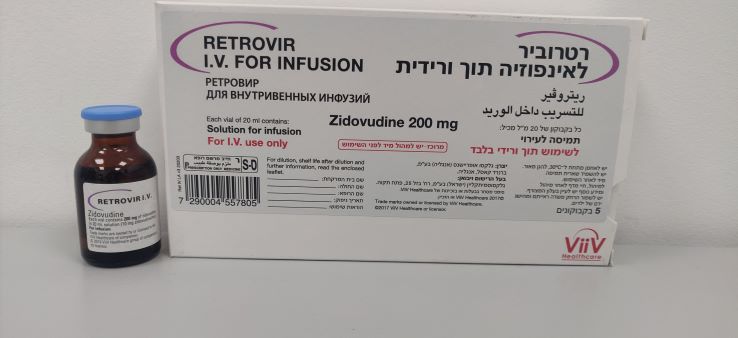Quest for the right Drug

רטרוביר לאינפוזיה תוך ורידית RETROVIR IV FOR INFUSION (ZIDOVUDINE)
תרופה במרשם
תרופה בסל
נרקוטיקה
ציטוטוקסיקה
צורת מתן:
תוך-ורידי : I.V
צורת מינון:
תמיסה לאינפוזיה : SOLUTION FOR INFUSION
עלון לרופא
מינוניםPosology התוויות
Indications תופעות לוואי
Adverse reactions התוויות נגד
Contraindications אינטראקציות
Interactions מינון יתר
Overdose הריון/הנקה
Pregnancy & Lactation אוכלוסיות מיוחדות
Special populations תכונות פרמקולוגיות
Pharmacological properties מידע רוקחי
Pharmaceutical particulars אזהרת שימוש
Special Warning עלון לרופא
Physicians Leaflet
Posology : מינונים
4.2 Posology and method of administration Retrovir should be prescribed by physicians who are experienced in the treatment of HIV infection. The required dose of Retrovir IV for Infusion must be administered by slow intravenous infusion of the diluted product over a one-hour period. Retrovir IV for Infusion must NOT be given intramuscularly. Dilution: Retrovir IV for Infusion must be diluted prior to administration (see section 6.6). Dosage in adults: A dose for Retrovir IV for Infusion of 1 or 2 mg zidovudine/kg bodyweight every 4 hours provides similar exposure (AUC) to an oral dose of 1.5 or 3.0 mg zidovudine/kg every 4 hours (600 or 1200 mg/day for a 70 kg patient). The current recommended oral dose of Retrovir is 250 or 300 mg twice daily. This current dose is used as part of a multi-drug treatment regimen. Patients should receive Retrovir IV for Infusion only until oral therapy can be administered. Dosage in children: Limited data are available on the use of Retrovir IV for Infusion in children. A range of intravenous dosages between 80-160 mg/m2 every 6 hours (320- 640 mg/m2/day) have been used. Exposure following the 120 mg/ m2 dose every 6 hours approximately corresponds to an oral dose of 180 mg/m2 every 6 hours. An oral dose of Retrovir of 360 to 480 mg/m2 per day approximately corresponds to an intravenous dose of 240-320 mg/m2/day. Dosage in the prevention of maternal-foetal transmission: Pregnant women (over 14 weeks of gestation) should be given 500 mg/day orally (100 mg five times per day) until the beginning of labour. During labour and delivery Retrovir should be administered intravenously at 2 mg/kg bodyweight given over one hour followed by a continuous intravenous infusion at 1 mg/kg/h until the umbilical cord is clamped. Neonates should be given 0.2 mL/kg (2 mg/kg) bodyweight orally every 6 hours starting within 12 hours after birth and continuing until 6 weeks-old. Care should be taken when calculating doses for neonates due to the small volumes of oral solution required. To facilitate dosing precision, an appropriately sized syringe with 0.1 mL graduation should be used to ensure accurate oral dosing of neonates (see oral solution SPC). Infants unable to receive oral dosing should be given Retrovir intravenously at 1.5 mg/kg bodyweight infused over 30 minutes every 6 hours. In case of planned caesarean, the infusion should be started 4 hours before the operation. In the event of a false labour, the Retrovir infusion should be stopped and oral dosing restarted. Dosage adjustments in patients with haematological adverse reactions: Substitution of zidovudine should be considered in patients whose haemoglobin level or neutrophil count fall to clinically significant levels. Other potential causes of anaemia or neutropenia should be excluded. Retrovir dose reduction or interruption should be considered in the absence of alternative treatments (see sections 4.3 and 4.4). Dosage in the elderly: Zidovudine pharmacokinetics have not been studied in patients over 65 years of age and no specific data are available. However, since special care is advised in this age group due to age-associated changes such as the decrease in renal function and alterations in haematological parameters, appropriate monitoring of patients before and during use of Retrovir is advised. Dosage in renal impairment: In patients with severe renal impairment, the recommended IV dosage is 1 mg/kg 3-4 times daily. This is equivalent to the current recommended oral daily dosage for this patient group of 300 – 400 mg allowing for oral bioavailability of 60-70%. Haematological parameters and clinical response may influence the need for subsequent dosage adjustment. For patients with end-stage renal disease maintained on haemodialysis or peritoneal dialysis, the recommended dose is 100 mg every 6-8 hrs (300 mg – 400 mg daily) (see section 5.2). Dosage in hepatic impairment: Data in patients with cirrhosis suggest that accumulation of zidovudine may occur in patients with hepatic impairment because of decreased glucuronidation. Dosage reductions may be necessary but, due to the large variability in zidovudine exposures in patients with moderate to severe liver disease, precise recommendations cannot be made. If monitoring of plasma zidovudine levels is not feasible, physicians will need to monitor for signs of intolerance, such as the development of haematological adverse reactions (anaemia, leucopenia, neutropenia) and reduce the dose and/or increase the interval between doses as appropriate (see section 4.4).

שימוש לפי פנקס קופ''ח כללית 1994
לא צוין
תאריך הכללה מקורי בסל
01/01/1995
הגבלות
תרופה מוגבלת לרישום ע'י רופא מומחה או הגבלה אחרת
מידע נוסף
עלון מידע לצרכן
23.12.15 - עלון לצרכן 22.08.17 - עלון לצרכן 17.01.19 - עלון לצרכן 10.03.19 - עלון לצרכן 02.11.22 - עלון לצרכן עברית 09.01.23 - עלון לצרכן אנגלית 09.01.23 - עלון לצרכן ערבית 01.03.23 - עלון לצרכן אנגלית 01.03.23 - עלון לצרכן עברית 01.03.23 - עלון לצרכן ערבית 13.10.21 - החמרה לעלון 14.09.22 - החמרה לעלוןלתרופה במאגר משרד הבריאות
רטרוביר לאינפוזיה תוך ורידית